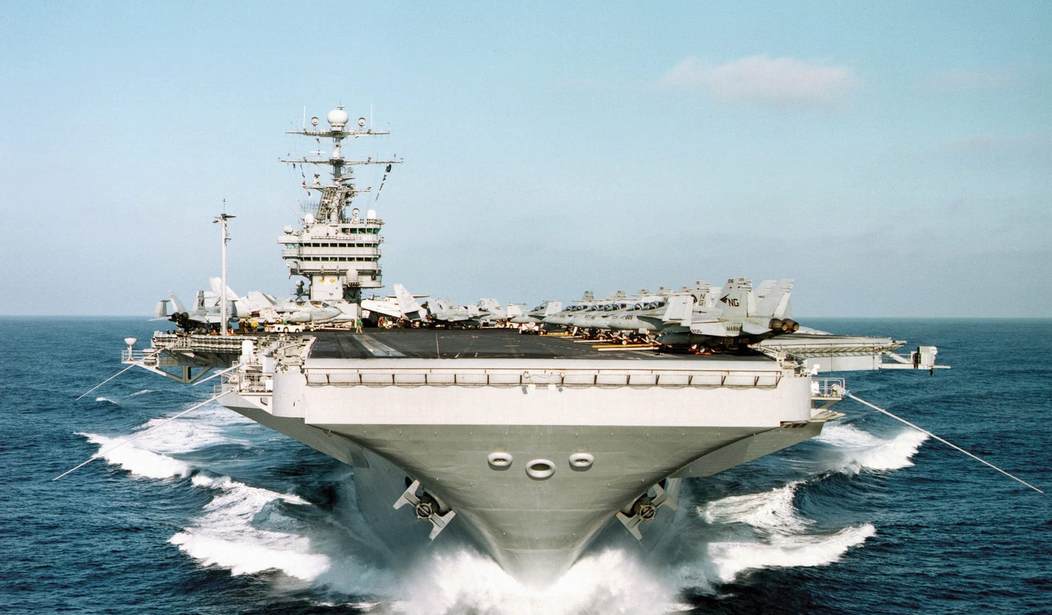It’s been a tough couple of weeks for proponents of naval power, as America’s and China’s two newest aircraft carriers revealed ongoing teething problems.
The U.S. Navy’s first-in-class USS Gerald R. Ford (CVN-78) nuclear-powered supercarrier is the revolutionary successor to the current 10-ship Nimitz-class warships. First laid down in 2008 and commissioned in 2017, the Ford is expected to enter combat service… someday. The Navy hopes to take delivery in October of this year, but delays keep mounting.
The Ford uses modern automation to achieve a much-reduced crew size of about 4,500 men (including aircrews), down from just over 6,000 on its more-conventional predecessors, like the USS Reagan currently on patrol in the South China Sea not far from Hong Kong. Other, perhaps more important advances, include a radical electromagnetic aircraft launch system (EMALS) instead of traditional steam catapults, and a high-speed elevator system for moving planes to the flight deck and weapons to the planes.
ASIDE: President Trump has said he wants the Navy to scrap EMALS and go back to a traditional steam catapult system, which is a bit like trying to retrofit a diesel semi engine into a sports car. China apparently plans to use EMALS in its future Type 002 CV.
The problem is the damn elevators still don’t work.
The Ford required some hard maintenance after sea trials revealed a manufacturing defect in its propulsion plant. The ship’s twin A1B nuclear plants were fine, but according to the Navy there was some unspecified defect “in the mechanical components associated in turning steam created by the nuclear plant into spinning screws that propel the ship through the water.” The Navy announced Monday that repairs had been completed near the end of July, but other problems remain.
The high-speed weapons elevators and the EMALS system are supposed to work hand-in-hand to generate more sorties (up to 25% more than a Nimitz), while causing less wear and tear to the aircraft being launched. Early problems with EMALS were mostly in software, but cost-cutting measures imposed by Congress mean the system won’t be fully operational on the first two Ford-class ships for years. Problems with the elevators have yet to be fully resolved, causing Republican Senate Armed Services Chairman Jim Inhofe to complain, “The ship was accepted by the Navy incomplete, nearly two years late, two and a half billion dollars over budget, and nine of eleven weapons still don’t work with costs continuing to grow.”
Once we’ve thrown enough money at the problems, the Fords ought to be the deadliest and most survivable class of carriers ever built, but it would be almost too kind to note that the Navy and Congress screwed the American taxpayer good and hard along the way.
Meanwhile, off the coast of China…
The People’s Republic continues its unprecedented peacetime naval buildup, but still hasn’t put to sea a single combat-worthy aircraft carrier.
China’s first aircraft carrier, the Liaoning, started life over three decades ago when she was first laid down for the Soviet navy. Abandoned unfinished at the end of the Cold War, it was purchased from Ukraine by a Chinese shell company in 1998, then given to the People’s Liberation Army Navy in 2002. Completed and brought into service in 2012, the Liaoning, tiny by American standards, serves mostly as a training vessel.
Beijing has spent years building its first homegrown carrier, the as-yet-unnamed Type 001A. Basically a bigger Liaoning, the 001A is still about a third smaller than a Nimitz or Ford, and is expected to carry less than half as many aircraft under a full combat load. It’s also conventionally powered, which means the Type 001A CV won’t be able to steam away from trouble nearly as effectively as an American CVN like the Ford.
Even so, China is having issues with the 001A. Business Insider reported late last week, “China’s first homemade aircraft carrier is going through back-to-back sea trials, suggesting there may be ‘technical problems.'” Beijing isn’t saying much, but:
China’s first home-grown aircraft carrier is undergoing another sea trial, straight after four days of testing, suggesting that the PLA Navy may have identified technical problems requiring immediate attention, military observers said.
The latest sea trial of the 65,000-tonne Type 001A was indirectly confirmed by a “no-sail zone” notice issued by the Liaoning Maritime Safety Administration on Monday. Ships have been warned not to enter a 3,400 sq km area in the north of the Yellow Sea for safety reasons.
The “safety reason” is probably “we’ll sink or shoot down anyone who gets too close to our secret new ship.”
Trouble is nothing to be surprised by, as Popular Mechanics noted earlier today, a “country like China, which has never built a carrier before, will naturally experience technical problems.” We’ve been building them since just after WWI nearly a century ago, and we still generate new problems with each new class. Experience is a harsh teacher, especially when the lesson is that you’ll always make mistakes.
That said, despite what you hear from various armchair admirals, the age of the aircraft carrier isn’t over. Not yet. While the U.S. Navy attempts an at-sea revolution with the Ford, China follows swiftly behind. The Type 001A will be followed by the bigger and more advanced 002, with plans for an even-more advanced Type 003 not far behind. Britain has built a pair of new carriers, its first full-size CVs in decades. Japan is looking at converting its “helicopter destroyer” warships into F-35 baby carriers (as is South Korea), and even Russia is trying to stay in the game with its single, cursed little Admiral Kuznetsov.
I just wish — at least in our case — it didn’t take so long and cost so much.










Join the conversation as a VIP Member